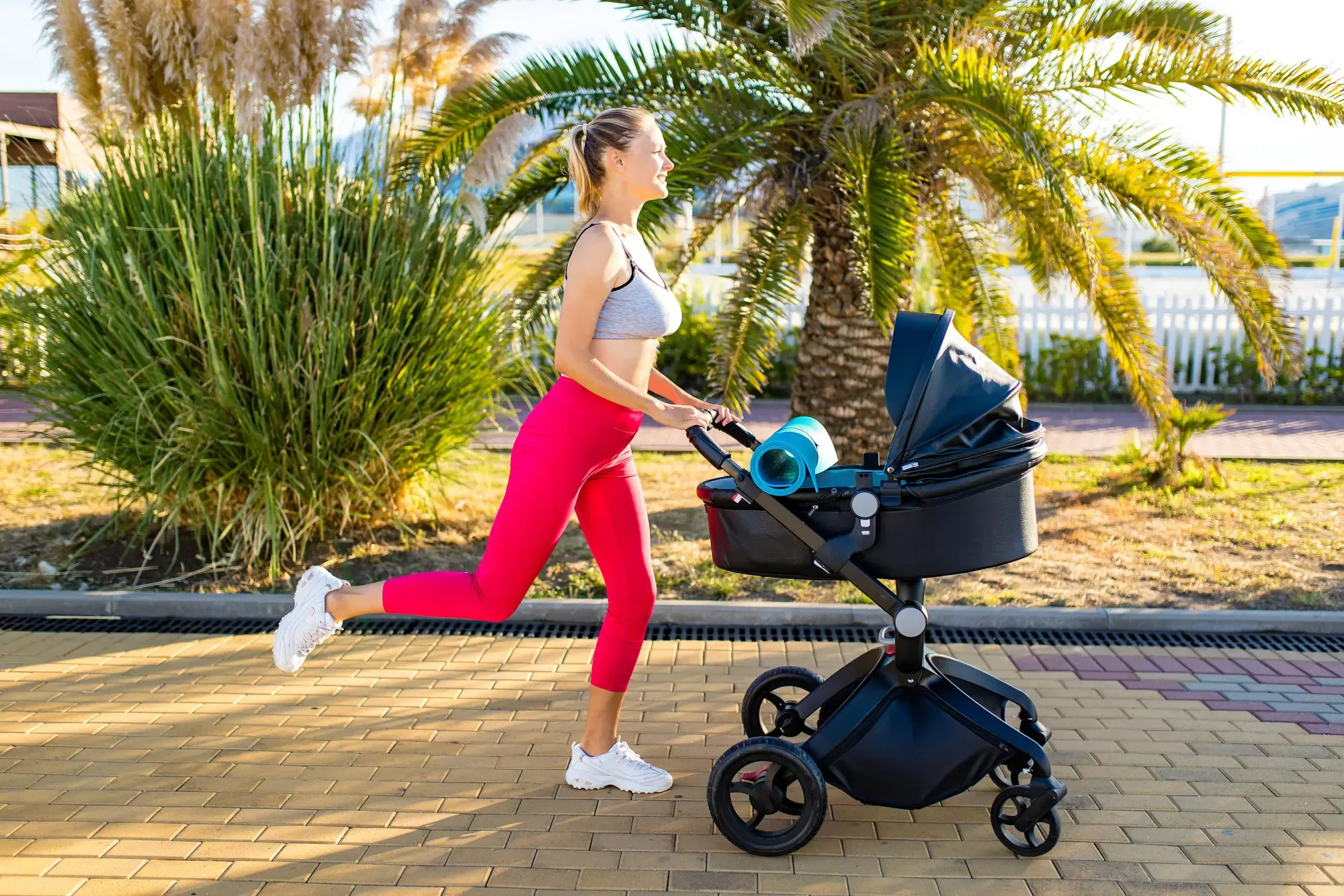Embarking on postpartum exercise is a vital step for new mothers seeking physical and mental well-being. However, the prospect of experiencing bleeding after running can be worrisome. This comprehensive guide, presented by Ironhorse Physical Therapy & Pilates in San Ramon, CA, aims to address postpartum bleeding concerns and provide effective management insights.
For new mothers eager to resume their running routine, the question “When can I run postpartum?” often lingers. The desire to return to pre-pregnancy fitness levels must be balanced with a gradual and mindful approach, especially considering the significant changes your body has undergone during pregnancy and childbirth.
This guide acknowledges the challenges new mothers face in reclaiming their fitness journey and focuses on a particular concern—bleeding or spotting during postpartum exercise. While it may initially seem disheartening, understanding the causes behind this issue is crucial for navigating a safe and effective return to running after childbirth.
What Causes Bleeding After Exercise Postpartum?
After delivering a baby, experiencing some light vaginal bleeding called “lochia” for 4-6 weeks is perfectly normal as your uterus sheds its lining. Blood flow typically starts out heavier for about a week and then lightens considerably over subsequent weeks as your uterine lining finishes regenerating.
When you begin gentle activity or exercise during this postpartum period, an increase or restart in vaginal bleeding or postpartum bleeding restarted is often noticed. Starting exercise too vigorously can disrupt the healing tissues and blood vessels in your vaginal canal and uterus. Having intercourse before six weeks postpartum also commonly causes minor bleeding.
The reasons postpartum exercise may trigger bleeding include:
- Increased blood flow to the pelvic region during physical activity
- Movement and bouncing cause disruption of healing tears or sensitive tissues
- Build up of intensity before the body is fully prepared
If you engage muscles stretched and strained during childbirth before allowing complete healing, you also risk provoking irritation and inflammation. Running and high-impact exercises will likely cause more bleeding than gentle walking or stretching. But any activity beyond what your body is currently prepared for could stimulate minor bleeding.
How Long Does Postpartum Bleeding After Exercise Last?
For most women, moderate postpartum bleeding after exercise bleeding or spotting after working out postpartum lasts only a day or two at most. Often, it stops shortly after cooling down from your workout. Any blood is typically light pink or brown rather than a bright red, which suggests it’s residual lochia mixing with fresh blood from sensitive tissues.
As long as the bleeding is minor and subsides quickly, it’s nothing to be alarmed about. However, if you experience heavy flow, like a menstrual period that continues for more than two days, contact your physician promptly. Heavy bleeding that persists could indicate:
- Infection
- Hemorrhage
- Failure of the uterine lining to heal
- Retained placental fragments
Any of these complications require medical attention to treat, so don’t ignore substantial bleeding. But sporadic spotting from exercising should resolve within a month or two. Monitor patterns carefully and adjust activity levels accordingly while your body recovers its equilibrium.
How Soon After Delivery Can You Run Safely?
If you’ve noticed postpartum bleeding becoming heavier after walking, rest assured that this guide is tailored to address your specific concerns. Most doctors recommend waiting at least 4-6 weeks after giving birth before gradually easing back into more challenging workouts like running. Some preset factors allow clearance for running sooner than the standard six weeks, including:
- Vaginal delivery without complications
- No lingering pain, soreness, or pelvic floor dysfunction
- No postpartum depression or anxiety inhibiting self-care
- Healthy BMI and aerobic conditioning pre-pregnancy
Checking in with your OBGYN or midwife around the 4-week mark is wise to address any concerns before pivoting back to running too abruptly after having your baby. If you had a C-section, wait the full 6 weeks minimum to allow sufficient scar tissue healing.
Early running relapses often backfire, causing frustrating setbacks like bleeding, pain, and injury that further stall your full recovery. Revisit running in careful moderation only after your lochia has tapered off completely and any pelvic or abdominal soreness has resolved. Give your body ample time to re-stabilize its mechanics for bearing weight without compensations leading to strain.
How to Run After Pregnancy Without Causing Bleeding
When your healthcare provider gives you the all-clear for exercise, you can start laying the foundation to run after pregnancy through brisk walking before gradually blending jogging. Moving slowly and steadily allows your pelvic floor, core muscles, and connective tissues to strengthen properly in preparation for running’s intense demands.
Here’s how to ease back into running safely after having a baby:
- Start with walking – Begin with 15-20 minute leisurely walks 1-2 weeks after delivery, then build duration weekly by no more than 10%. Listen closely for pain signals.
- Add pelvic floor work – Engage urinary/anal sphincters intermittently during walks to connect with deep stabilizers. Do dedicated Kegels 2-3x/day.
- Pay attention to form – Maintain an upright posture without heavy steps that create jolting or pounding. Land softly from heel to toe without overstriding.
- Try jog/walk intervals – When you can walk 30+ minutes without discomfort, add 30 seconds of very light jogging intervals followed by relaxed walking to recover.
- Limit impact – Choose softer surfaces like grass, trails, or tracks over harder ones like concrete when integrating running. Use shock-absorbing shoes with ample cushioning.
- Check for leaks – Cough, laugh, and jump post-walks, checking for urine loss, which means the core/pelvic floor needs more retraining before running intensity progresses.
The balancing act lies in exercising enough to rebuild fitness without overdoing activity that risks provoking bleeding or harm. Let your symptoms guide you on when to pull back or push forward cautiously. Infrequent minor spotting generally means you can carry on while recurring heavy bleeding demands more rest.
Other Causes of Postpartum Bleeding When Active
While bleeding after exercise postpartum is rarely problematic, bleeding outside the norm merits medical evaluation. Call your doctor if you have any of the following:
- Heavy flow like a menstrual period over 2 days
- Bright red blood instead of pink or brown
- Blood clots larger than a quarter
- Foul-smelling lochia
- Uterine/vaginal pain and cramping
- Bleeding persisting longer than 6 weeks postpartum
Rarer complications causing abnormal bleeding patterns post-delivery include:
- Subinvolution: enlarged uterus slow to shrink
- Infection: uterine lining inflamed
- Retained products of conception: leftover placental fragments
- Bleeding disorders: von Willebrand disease, immune thrombocytopenia
- Structural causes: cervical/vaginal lesions, varicose veins
Diagnostic testing like pelvic ultrasound, CT scans, or endometrial biopsy helps determine any underlying disorder that contributes to ongoing bleeding beyond lochia. Treatment options range from antibiotics for infection to possible D&C procedures for retained tissue removal to medically managing clotting issues.
In addition to consulting your OBGYN or midwife quickly with significant bleeding concerns, seeking pelvic floor physical therapy assessment offers value. Specialized PTs expertly evaluate posture, alignment, core function, muscle mechanics, and structural instabilities that could exacerbate bleeding after running postpartum.
Customized treatment regimens aimed at correcting dysfunction improve stability and control to prevent complications. Addressing alignment and strength imbalances builds resilience against bleeding as running intensity amplifies. If you want a customized treatment plan for your hip pain, you can contact Ironhorse Physical Therapy & Pilates in San Ramon, CA.
How Can a Physical Therapist Help You Run After Pregnancy?
Consulting a pelvic floor physical therapist equipped to assess and treat postpartum complications gives you a tremendous advantage in transitioning back to running safely. Rather than struggling through pain and bleeding independently, PTs comprehensively evaluate, diagnose, and correct dysfunction.
By honing in on the specific weaknesses and imbalances behind your symptoms, skilled PTs design customized treatment regimens to restore stability and optimal function. Their goal is to build resilience to withstand running’s demands through the healing phases.
Physical therapists help guide a safe return to running after having a baby through:
- Postural assessment analyzing spine alignment and load distribution
- Movement analysis checking form, mechanics, and control
- Pelvic floor examination for leakage, weakness, or tightness
- Physical Therapy in San Ramon CA, to improve tissue mobility and reduce scar tissue
- Core stability retraining to distributive forces evenly
- Gait evaluation assessing stride length, cadence, balance, and impact
- Corrective exercise focused on positioning and mechanics
- Graduated programming to build impact tolerance progressively
- Pain modulation and edema reduction
- Patient education on modifying activities to avoid bleeding
Conclusion
Bleeding after running postpartum generally causes more fear than actual harm. Light spotting or bleeding relates to the vulnerable pelvic floor and core tissues struggling to stabilize the intensity running unleashed throughout the body. Mastering a safe return to exercise after delivering a baby requires respecting classic warning signs like bleeding to adjust appropriately.
Seeking pelvic floor physical therapy services and Running Gait Analysis in San Ramon, CA through practices like Ironhorse Physical Therapy & Pilatesfine tunes dysfunction behind symptoms to build resilience. Collaborating with your care team ensures you come back stronger without compromises that detract from running’s joy long-term. Soon enough, you’ll sprint ahead in training as a badass mom runner again.


